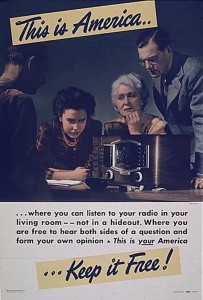 I’m blogging about this World War II United States propaganda poster for no other reason than that I just love it. I adore that young woman in the middle there, brows clenched, fist clenched, leaning over a notebook with a shadow across her forehead, staring at and listening to that radio as if her life depended on it.
I’m blogging about this World War II United States propaganda poster for no other reason than that I just love it. I adore that young woman in the middle there, brows clenched, fist clenched, leaning over a notebook with a shadow across her forehead, staring at and listening to that radio as if her life depended on it.
“This is America . . . ” the poster declares, ” . . . where you can listen to your radio in your living room — not in a hideout. Where you are free to hear both sides of a question and form your own opinion. This is your America.”
The graphic and message were part of a series of pictures circa 1942 that all emphasized the same “This is America” slogan, produced by the Sheldon-Claire graphics company. The historian David A. Gray offers this context:
“Placed in work areas and high-traffic locations throughout the factory, the posters gave workers visual reminders about the imperatives of American victory in the war and emphasized the virtues of the American Way of Life and its rewards for those who worked hard. Each poster included a colorized photograph and brief copy which succinctly conveyed the poster’s message and linked it to the campaign theme. With bold captions, the thirty posters portrayed Americans in a variety of situations, such as at work, at home, and at leisure, and harmonized these scenes within a narrative of patriotism and free-enterprise values.”
There are so many ways to read this radio poster. First, note how critical those two women are to the picture. They listen right in the middle of the scene. Almost all the light focuses on them. The men pose like side columns (although they stand while the women sit).
No surprise that the graphic foregrounded women. As millions of men shipped overseas, the government begged their wives, sisters, and mothers to take up the industrial slack in defense plants. They became primary economic figures, treated as primary civic figures as well. At least, that is, until the end of the war; I would be hard pressed to identify a graphic similar to this appearing on the American social landscape from 1946 through the mid-1960s.
Then there’s the “free to hear both sides of a question and form your own opinion” angle. As Victor Pickard notes in his history of mid-20th century broadcast regulation, through the war and post-war years, Federal Communications Commission staff focused intensely on the problem of how to prevent broadcasters from turning radio stations into their own personal editorial soap boxes. At first they experimented with strictures against editorializing, then mandated a rule requiring fair access to contrasting points of view on any radio station’s public affairs schedule. The FCC also pushed NBC to divest itself of one of its two networks and urged stations to set limits on commercials.
Again, it shouldn’t surprise us that this poster, produced by an industry friendly company, suggested that radio had already fulfilled the fairness mission. So successfully, in fact, that it was something worth fighting for.
Last but not least, note the ashtray and cigarettes sitting prominently on the table before the console. In fact, they’re the only objects placed on the table before the console. Are we to believe that in 1942 nobody listened to radio while drinking coffee, munching on sandwiches, or, heaven help them, reading a magazine? Welcome to the Golden Age of Smokes. They were sold free of regulation or any meaningful scrutiny for another quarter century. Americans paid a hefty price tag for that version of freedom, but this is a radio blog, so we won’t go there . . .



